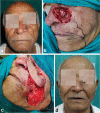Propeller Flaps
- PMID: 36683892
- PMCID: PMC9859681
- DOI: 10.1055/s-0041-1740529
Propeller Flaps
Abstract
A propeller flap is an islanded flap that reaches the recipient site through an axial rotation around its vascular axis. The degree of rotation varies from 90 degrees to 180 degrees. It is a highly reliable local reconstructive option. These flaps are simple, single-stage, easy to harvest, and not constrained by routine length-to-width ratios. Since their introduction, the technique has continued to evolve and more applications for the use of propeller flaps are being explored. In spite of their growing use in clinical practice in recent years, many reconstructive surgeons are unaware of their versatility, unsure of their safety, and apprehensive about using propeller flaps confidently. This article aims at understanding the nomenclature, key principles, biogeometry and planning, operative technical details, applications, and complications of propeller flaps.
Keywords: biogeometry; extremity flaps; head and neck flaps; local flap; perforator flap; post-burn reconstruction; propeller flap.
Association of Plastic Surgeons of India. This is an open access article published by Thieme under the terms of the Creative Commons Attribution-NonDerivative-NonCommercial License, permitting copying and reproduction so long as the original work is given appropriate credit. Contents may not be used for commercial purposes, or adapted, remixed, transformed or built upon. ( https://creativecommons.org/licenses/by-nc-nd/4.0/ ).
Conflict of interest statement
Conflict of Interest None declared.
Figures






Similar articles
-
Clinical applications of perforator-based propeller flaps in upper limb soft tissue reconstruction.J Hand Surg Am. 2011 May;36(5):853-63. doi: 10.1016/j.jhsa.2010.12.021. Epub 2011 Apr 12. J Hand Surg Am. 2011. PMID: 21489723
-
The "Tokyo" consensus on propeller flaps.Plast Reconstr Surg. 2011 Feb;127(2):716-722. doi: 10.1097/PRS.0b013e3181fed6b2. Plast Reconstr Surg. 2011. PMID: 21285776
-
The Utility and Versatility of Perforator-Based Propeller Flaps in Burn Care.J Burn Care Res. 2017 Jan/Feb;38(1):20-27. doi: 10.1097/BCR.0000000000000447. J Burn Care Res. 2017. PMID: 27755250
-
Our Definition of Propeller Flaps and Their Classification.Semin Plast Surg. 2020 Aug;34(3):139-144. doi: 10.1055/s-0040-1715158. Epub 2020 Sep 22. Semin Plast Surg. 2020. PMID: 33041682 Free PMC article. Review.
-
Propeller Flaps in the Head and Neck.Semin Plast Surg. 2020 Aug;34(3):165-170. doi: 10.1055/s-0040-1714269. Epub 2020 Sep 22. Semin Plast Surg. 2020. PMID: 33041686 Free PMC article. Review.
Cited by
-
Applications and Reliability of Dorsal Metacarpal Artery Perforator Flap.Indian J Plast Surg. 2023 Sep 25;56(6):519-525. doi: 10.1055/s-0043-1773771. eCollection 2023 Dec. Indian J Plast Surg. 2023. PMID: 38105876 Free PMC article.
References
-
- Hou C, Chang S, Lin J, Song D. Dordrecht: Springer Sciences + Business Media; 2015. Pedicled perforator flaps; pp. 15–26.
-
- Katsaros J. Use of the island tensor fasciae latae flap to cover a chest-wall defect. Plast Reconstr Surg. 1982;69(06):1007–1009. - PubMed
-
- Hyakusoku H, Yamamoto T, Fumiiri M. The propeller flap method. Br J Plast Surg. 1991;44(01):53–54. - PubMed
LinkOut - more resources
Full Text Sources

